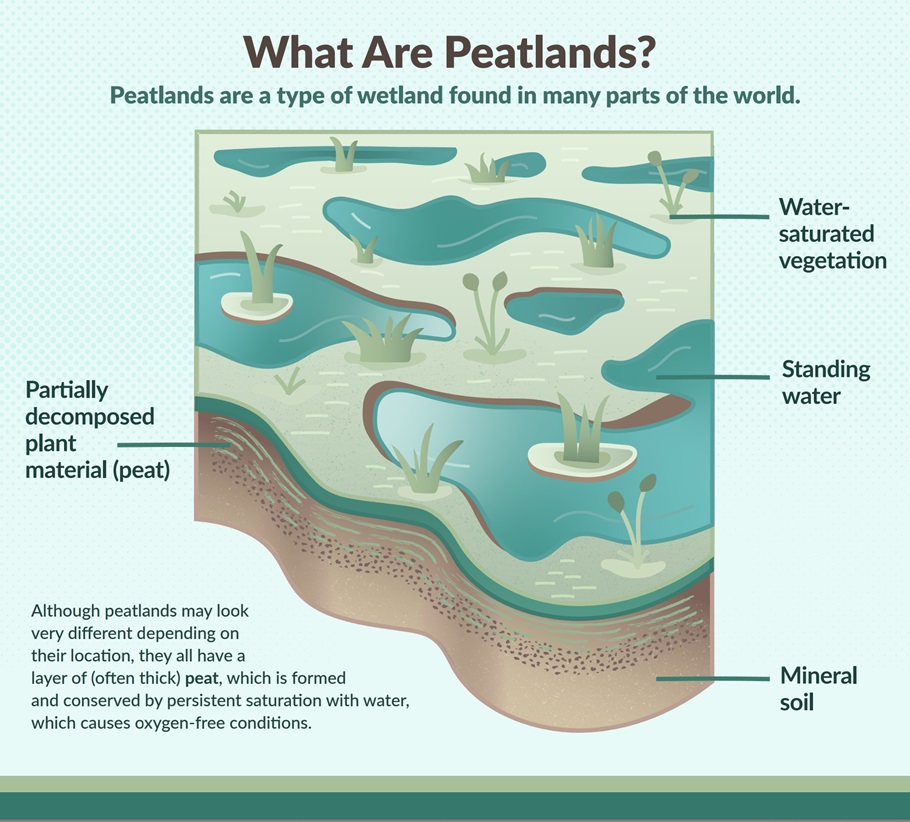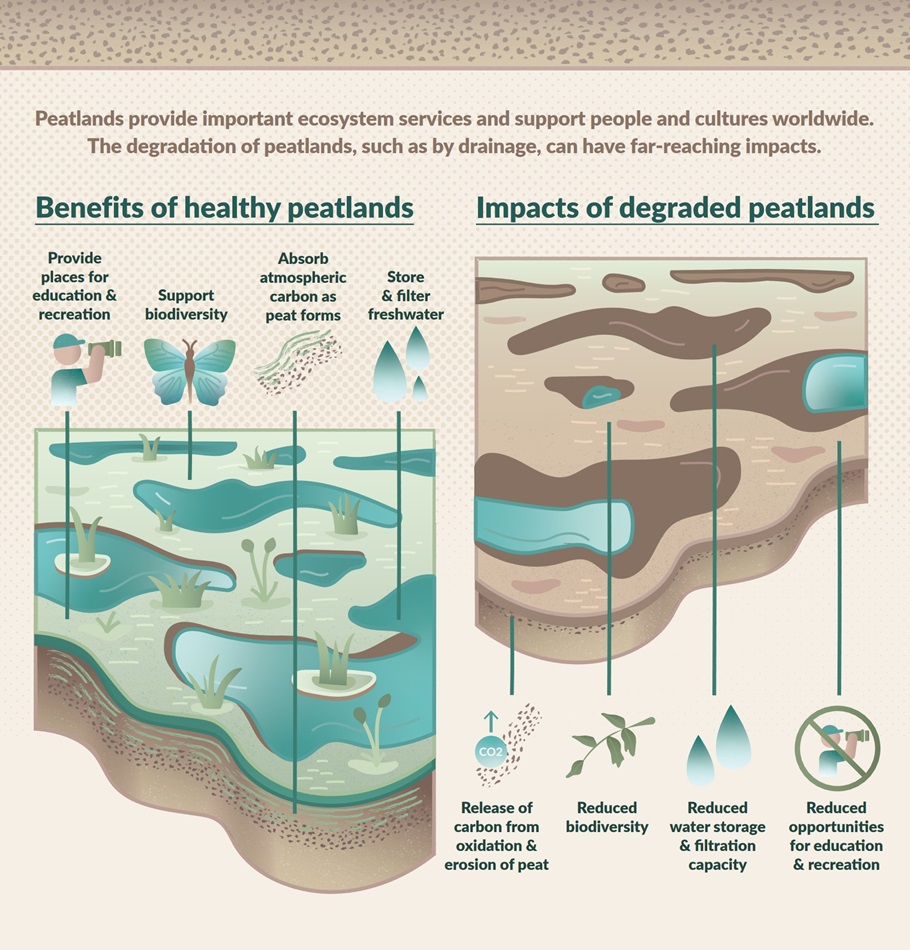Last updated on January 25th, 2024
Known by many names—from fen, bog, and marsh to mire and swamp—peatlands are a type of wetland that plays important roles in the environment, including absorbing carbon from the atmosphere and supporting an abundant array of wildlife. They also provide numerous benefits to people, including drinking water and food as well as recreational and educational activities. But many of these benefits may not be around for long, because peatlands around the world face myriad threats to their existence.
That’s why The Pew Charitable Trusts is working to improve peatland conservation in many regions of the world, in part by seeking to fill gaps in research and advocate for strong policies to safeguard these ecosystems. Here, we delve into what exactly peatlands are, how they support wildlife and people, and what lies ahead for peatland conservation science.
An introduction to peatlands
Although there is no universally accepted definition of peatlands, scientists most often describe them as a class of wetland with a naturally accumulated layer of dead plant material, or peat, at the surface. Peat is formed when organic matter accumulates faster than it decomposes because of a lack of oxygen in waterlogged matter. In areas where peat accumulation has continued over long periods of time, the land may have layers of peat that are meters thick. Although all peatlands are wetlands, not all wetlands are peatlands.

There are two major types of peatlands: bogs and fens. Bogs are fed by precipitation, whereas fens receive water and nutrients from other sources, such as groundwater. Because peat can accumulate only in perennially waterlogged places, the distribution and characteristics of peatlands largely depends on local conditions, such as weather and freshwater inputs. Peatlands are found in and near fresh and brackish waters, and in coastal and inland areas around the world. As a result of their broad geographic coverage and highly diverse characteristics, peatlands are often unrecognized and overlooked by governments and policymakers.
Peatlands occupy only about 3% of the global land area but contain about 25% of the global soil carbon stock—twice the amount found in the world’s forests. These wetlands store older carbon in their peat layer for the long term, and in vegetation for the shorter term. Peatlands are also home to rich biodiversity, including a wide range of threatened and endemic species, and provide important places for recreational, spiritual, inspirational, educational, and other cultural activities for communities. In addition, peatlands support livelihoods with activities such as animal grazing. They also help to control flooding and filter sediments, pollutants, and other nutrients from sources of drinking water.
Threats and impacts
Scientists estimate that 15% of global peatlands have been drained for land development and agriculture, resulting in significant greenhouse gas emissions through release of the carbon that those wetlands were storing over long periods of time. The world’s carbon-rich soils, mostly located in boreal areas, are disproportionally drained in tropical regions—an action that accounts for more greenhouse gas emissions than the draining of temperate and boreal peatlands. Notably, half of the world’s known peatland emissions come from Southeast Asia, where high rates of deforestation and drainage and high temperatures speed the decomposition. Recent research estimates that current greenhouse gas emissions from drained or burned peatlands globally account for 5% of all emissions caused by human activity.

Importance of global peatland conservation
To date, most peatland conservation has used one or more of the following approaches: conserving intact peatlands, rewetting drained peatlands, applying climate-responsible peatland management, or implementing adaptive management where rewetting is not possible.
Scientific studies have estimated that peatland restoration would prevent the release of 394 million tons of carbon dioxide equivalent per year, an amount slightly larger than Australia’s annual emissions. But altering drainage patterns and local hydrogeography can be costly, so key industries or communities benefiting from extractive uses of peatlands may push back on restoration efforts. In addition to restoration, preventing peatlands from being disturbed could also yield substantial climate benefits and may be more economically feasible than restoration in some regions or under specific circumstances. This also highlights the need for equitable access to creative financing solutions so that communities can fund these conservation and restoration activities.
How science can help to improve peatland conservation
Despite the important role that peatlands play in sequestering carbon, the scientific community is not currently able to factor them into future climate models and projections, largely because of gaps in data and research. To address these data gaps, additional research is needed to better understand:
- The status and extent of global peatlands, particularly in data-poor regions.
- Peatland contribution to greenhouse gas fluxes.
- The impacts of climate change and other human-made stressors on peatlands.
- The costs and benefits of peatland conservation and restoration to deliver ecosystem services, such as those mentioned above, to people.
The development of standardized approaches to map and quantify peatlands should enable natural resource managers to adapt conservation approaches to different peatland types and locations. Similarly, governments and other key stakeholders can use improved baseline information to track peatland restoration, which may even play a role in verification standards as carbon markets for financing peatland conservation efforts are developed.
Peter Edwards is an officer and Kathrynlynn Theuerkauf is a principal associate with The Pew Charitable Trusts’ conservation science project.
This article was originally published by the Pew Charitable Trust.
Learn more about Peatlands by visiting U.S. Nature4Climate’s Decision-Makers Guide to Natural Climate Solutions Science.
